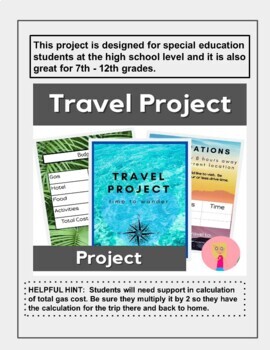Travel Budget Project- Middle & High School/Special Education/ESL- SUB PLANS
JAM Academy
13 Followers
Grade Levels
6th - 12th, Homeschool
Subjects
Resource Type
Standards
CCSSMP1
Formats Included
- PPTX
- Internet Activities
Pages
7 + ways to accommodate/modify project
JAM Academy
13 Followers
Compatible with Digital Devices
The Teacher-Author has indicated that this resource can be used for device-based learning.
What educators are saying
I used this with my inclusion class. The activity was engaging and reinforced how math is used in the real world.
Also included in
- These are great as SUB PLANS.The research project bundle focuses on three important aspects of adult life: buying your first car, buying or renting a home, and planning a trip. Each topic is significant in its own way and requires careful consideration before making a decision.Research How To Buy YoPrice $14.00Original Price $15.00Save $1.00
Description
This engaging travel research project requires no preparation and encourages students to explore the expenses associated with road trips. Students will be tasked with planning a 5-day/4-night trip to a destination that is within 8 hours of their current location.
Students will be guided through the process of researching and determining the costs of various trip components, including accommodations, meals, fuel, and activities. They will also have the opportunity to make independent decisions based on their allocated budget. Also a great activity for sub plans.
Total Pages
7 + ways to accommodate/modify project
Answer Key
N/A
Teaching Duration
3 days
Last updated Jul 14th, 2022
Report this resource to TPT
Reported resources will be reviewed by our team. Report this resource to let us know if this resource violates TPT’s content guidelines.
Standards
to see state-specific standards (only available in the US).
CCSSMP1
Make sense of problems and persevere in solving them. Mathematically proficient students start by explaining to themselves the meaning of a problem and looking for entry points to its solution. They analyze givens, constraints, relationships, and goals. They make conjectures about the form and meaning of the solution and plan a solution pathway rather than simply jumping into a solution attempt. They consider analogous problems, and try special cases and simpler forms of the original problem in order to gain insight into its solution. They monitor and evaluate their progress and change course if necessary. Older students might, depending on the context of the problem, transform algebraic expressions or change the viewing window on their graphing calculator to get the information they need. Mathematically proficient students can explain correspondences between equations, verbal descriptions, tables, and graphs or draw diagrams of important features and relationships, graph data, and search for regularity or trends. Younger students might rely on using concrete objects or pictures to help conceptualize and solve a problem. Mathematically proficient students check their answers to problems using a different method, and they continually ask themselves, "Does this make sense?" They can understand the approaches of others to solving complex problems and identify correspondences between different approaches.






